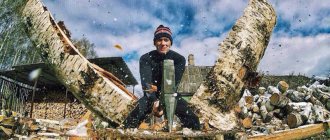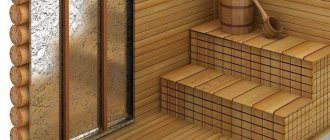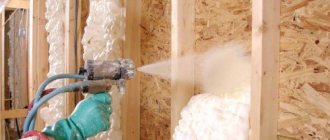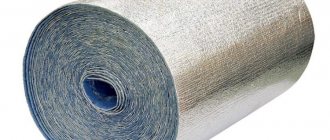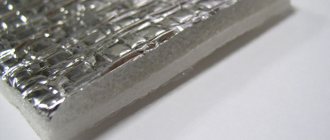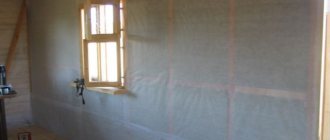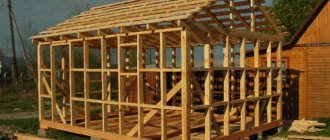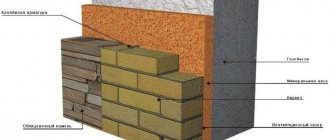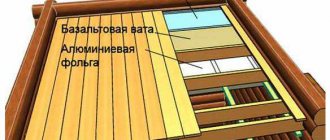Foil properties
Among the characteristics that bath and sauna foil has, the most important is the ability to reflect about 97% of infrared rays. If this material is used to cover the steam room continuously, the thermal energy will be retained as much as possible. The fact is that IR rays are not absorbed by the walls, but are reflected towards the room.
Foil is ideal for a steam room because:
- the material can withstand temperatures up to 300 degrees and even higher - this property depends on its type;
- does not emit substances harmful to the human body;
- has a small specific gravity.
In addition, aluminum foil has the following advantages:
- moisture resistance;
- plasticity;
- durability;
- vapor tightness;
- resistance to corrosive processes.
When using this material, almost all the heat remains in the steam room, while the insulation for the bath with foil on the walls will be reliably protected from condensation. The fastening process is simple, the main thing in the work is to avoid deformation and not leave gaps between the panels.
To achieve a greater effect, foil insulation for a bathhouse is sheathed not only on the walls, but also on the ceiling surface, since steam and hot air first rise upward.
Features of installation of foil insulation
If work is carried out in a log house, then, as a rule, foil insulation is used. The material can be attached directly to logs (beams) using a stapler with the aluminum side facing the inside of the room. Depending on the thickness of the cladding, butt or overlap joints are used. The joints are taped with metallized tape.
Air gap between foil and lining
To drain condensate, it is planned to release foil material from the ceiling to the wall, and from the wall to the floor. Slats with a thickness of at least 3 cm are attached on top of the foil insulation. They perform two functions: they serve as a lathing for the finishing cladding and form an air gap between the foil and the lining. The gap is important in order to exclude direct heat transfer from the lining through the aluminum layer.
The arrangement of baths in rooms with brick or concrete walls has a single, but very significant difference from work in log houses: contact of foil material with the load-bearing wall is strictly unacceptable. First, the main insulation is carried out with heat insulators of sufficient thickness. Then the foil material is installed. The gap between the foil plane and the finishing lining must be observed.
Another important note for all types of baths and saunas equipped on the principle of a thermos using foil: such rooms must have high-quality ventilation.
Being a 100% vapor barrier, aluminum promotes the formation of condensation. Only intensive air exchange between bathing sessions can promote the natural evaporation of accumulated moisture.
Rolled aluminum foil
Foil is produced in both rolls and sheets. Roll material can have a thickness from 0.007 to 0.2 millimeters, a width of 10–1500 millimeters. The percentage of aluminum content in it is up to 99.5%.
Depending on the type of surface, foil is:
- smooth, without additional finishing;
- for finishing;
- finishing
According to the scope of application, the material is divided into canvas:
- food;
- technical;
- tape
Depending on the manufacturing method, foil is distinguished:
- soft (annealed), marked “M”;
- solid (unannealed) – it is assigned the letter “T”.
A quality product is a fabric that has no folds, stains, tears or other inclusions on the surface. When viewing a thin fabric against the light, it should have no tears or tiny holes. Thick foil is allowed to have a small number of holes, which is regulated by the technical parameters of the equipment used.
Thin fabric is wound on bushings having different diameters. Thick foil is produced in sheets.
Before starting insulation work, developers are interested in how much foil for a bathhouse costs. Domestic roll products will cost less than imported material. With a roll length of 25-30 meters, the price will be approximately 20-30 dollars.
Insulation of walls using foil insulation
Thermal insulation must be resistant to hot air with an average temperature of +100°. The environmental friendliness of the coating under the influence of thermal loads is taken into account. Hot steam permeability is below 0.02 g/m².
The building material used in the construction of the walls of the bathhouse affects the choice of reinforced fabric, installation of insulation and the thickness of the covering layer.
Insulation of a bathhouse from a wooden frame
Before finishing work, the building must shrink. The walls of the log house are carefully caulked on both sides before insulation.
The covering is laid and secured with staples over the entire surface of the wall without gaps or gaps. Damage should be sealed with aluminum tape. The joints of the insulation are also glued to achieve tightness.
Slats 30x50 mm thick are fixed on top of the foil paper. The board trim is fixed on them. The thickness of the slats creates the effect of ventilation underneath.
Insulation of a bathhouse made of brick and concrete
Walls made of brick, concrete or foam blocks differ in the order of installation work.
- The first step is marking and calculating the sheathing on the walls. The bars are selected according to the thickness of the insulating layer, since it is inserted flush. The distance between the beams is equal to the size of the insulation sheet. Ventilation windows are lathed for easy installation of foil. The bars are mounted in a vertical position.
- Aluminum foil for the bath is fixed to the surface. The joints are sealed with metallized tape and additionally secured with staples. The foil is carefully fixed to the ventilation windows.
- The insulating material with foil is secured with horizontal bars. Sheathing is placed on top of the beams. The clearance created by the thickness of the beams will serve as ventilation for air and steam. The foil also protects the insulation and sheathing from moisture.
Reliability and long-term use of foil insulating materials are important qualities. Before purchasing, please read the warranty periods.
Also ask for information on the operation of this insulation, according to customer reviews. Only such an analysis provides the opportunity to select a worthy insulating material.
Using foil to insulate baths
To determine which foil to use for a bathhouse is better, you need to take into account what material the structure is built from and the conditions of its operation. If the building is made of logs with carefully caulked walls, then it does not require foil insulation.
In the case where the bathhouse is built of natural wood, but is large in area and does not heat up well, experts recommend lining the ceiling and walls from the inside with thin foil, and then covering it with clapboard. You can use a foil sheet for the surface behind the heating unit, as a result of which the steam room will warm up faster.
Despite the fact that a bathhouse made of foam concrete is considered warm, it requires high-quality vapor barrier, so the use of foil will be justified, but it is better to opt for laminated products.
Frame and brick buildings must be insulated. Insulation for a bathhouse with foil based on polystyrene foam and mineral wool is ideal for this (read: “How to insulate a frame bathhouse - nuances from the master”). The type of this material is selected for ceilings taking into account the thickness of the ceiling and the absence/presence of thermal insulation in the attic.
In addition, operating conditions matter. If the bathhouse is used infrequently and the procedures are not carried out for long, there is no need to insulate it with foil. When the steam room is used frequently and is kept in it for a long time, high-quality thermal insulation will save fuel, and the room will quickly warm up and cool down for a long time.
Benefits of use
Aluminum foil, GOST 618-73, a rather fragile material that is necessary to create an insulating layer for baths and saunas, is used either in the form of a regular aluminum film or in combination with a substrate.
A heat insulator is necessary to increase the efficiency of the bath. The benefits of its use are as follows:
- promotes rapid heating of the room;
- retains heat, preventing it from escaping;
- protects walls and a layer of insulation from the destructive effects of moisture and steam;
- protects against the formation of mold and mildew;
- withstands high temperatures and temperature changes;
- extends the life of the building as a whole.
Environmentally friendly foil is non-corrosive, non-toxic, environmentally friendly, and meets all sanitary and hygienic requirements.
On a note! The use of foil is useful; energy consumption (electricity, firewood) is reduced by at least a third! The service life of the bath is doubled! The material is inexpensive and easy to install.
The benefits of use are obvious; it is only important to choose the right material for the steam room and other rooms of the bathhouse and sauna.
Performing a simple bath lining
When covering the walls of bath buildings, the foil sheet is attached to the surface or on top of a layer of thermal insulation. This work will take little time and will not require much effort.
The process looks like this:
- Before covering the bathhouse with foil, a frame made of wooden planks is fixed to the wall.
- Insulation is placed between the slats.
- The top of the heat-insulating material is covered with overlapping foil, the joints between the strips are glued using aluminum tape.
- The foil is sheathed with clapboard and a 15-20 cm air gap is required between it and the surface of the foil. This is a prerequisite for effective heat transfer.
The air gap will reduce the thermal conductivity of aluminum, and since the hot lining will not come into contact with the foil, due to the insulating properties of the air, direct heat transfer will become impossible. At the same time, infrared rays hitting the surface of the foil sheet will be reflected towards the steam room.
Which one to choose
The basis of the foil is a thin metal sheet. It is made only from aluminum. This is due to its technological feature, which allows aluminum to be rolled into very thin sheets. Not all metals have such a ductility coefficient.
Copper is on par with aluminum, but when rolled into thin layers, it oxidizes. Only aluminum remains suitable, so there are no options for metal. Aluminum already has excellent performance properties. Bath insulation with foil can be produced by the manufacturer in a variety of options.
The main types of foil insulation used in baths
- Foil + foamed polyethylene (Folgisolon), single-sided and double-sided coating, different thickness of the polyethylene layer;
- Foil-coated mineral wool. The aluminum coating is only double-sided.
- Bath foil reinforced with kraft paper (Kraft foil). It does not have an insulating layer.
- Foil + fiberglass mesh (Folar). It is heat resistant.
- Regular construction foil without a base. Requires careful gluing and good protection followed by a finishing layer.
The choice of which foil is best for a bathhouse is made based on design documentation, construction budget and availability on the local construction market. If the requirements for safety and environmental friendliness are the highest, then paper-based foil for a bath or without a base at all is optimal.
If the quality requirements are standard, then the foil thermal insulation for a bathhouse can be anything, as long as it comes from a certified manufacturer.
If the bath already has a good layer of insulation, then there is no point in purchasing foil on foamed polyethylene or mineral wool.
It is for such options that foil is made on kraft paper for a bath or fiberglass mesh.
These additional materials are added to the foil not for insulation, but for strength.
There are a huge variety of specific brands of foil: Alufom, Resurs Megaflex, foil for a bath of any brand should have a uniform surface. There should be no stains, streaks, thinning or untaped areas. This is the main indicator of quality.
Foil is not difficult to produce, and aluminum has a low melting point. This is why there are so many manufacturers of foil and foil materials. It is recommended to pay attention to certified products.
Types of insulation with foil for baths
During operation, a thin, soft foil sheet is easily wrinkled and torn, which is why new technologies for its use have emerged.
Currently on sale:
- foil paper;
- textile;
- insulation.
Foil paper
Its other name is laminated foil on a paper base for a bath. It is an elastic and dense material and has excellent vapor barrier properties. It is produced in two types: foil plus kraft paper and foil plus paper plus polyethylene.
Foil paper can withstand 130-degree heat. Resists compressive loads. It holds its shape and is easy to cut. The standard strip width is 120 centimeters. Self-tapping screws, construction staples and nails are used to secure it. The material is used for lining the inside of baths. It is not recommended to use laminated foil on the surface of walls adjacent to the stove.
Foil fabric (foil fabric)
This soft two-layer material is made from fiberglass and foil. The thickness of the foil fabric is in the range of 0.12–3 millimeters. The panels need to be fastened end-to-end. Foil fabric is used to insulate bathhouses; it can be used to sheathe walls near the heating unit.
Its main characteristics:
- ability to withstand temperatures up to 500 degrees;
- resistance to mold and other harmful microorganisms;
- good moisture resistance.
Foiled polystyrene foam
The insulation is made from expanded polystyrene and covered with a thin layer of aluminum foil. The material is produced in sheets measuring 1.2 x 0.6 meters with a thickness of 2-10 centimeters. They are used to insulate the premises of a bathhouse building from the inside. The sheets are equipped with stepped locks that prevent the formation of cold bridges.
Foiled polystyrene foam has the following qualities:
- does not absorb moisture;
- reflects about 98% of thermal energy;
- differs in vapor barrier properties;
- resistant to chemical influences;
- safe for health;
- has a long service life.
Foil polyethylene foam
This roll insulation with a thickness of 2 to 10 centimeters has a one-sided or double-sided foil coating. It is used when arranging thermal insulation for the interior of baths.
This material can withstand temperatures of no more than 100 degrees. It is not used for covering surfaces near the stove.
Foil mineral wool
It is produced in rolls or in the form of mats of different thicknesses. Has excellent thermal insulation properties. Ideal for insulating frame bath buildings. The use of rolls or mats with foil makes finishing work easier and more convenient.
Types of foil products
Plain Rolled Aluminum Foil
Our industry produces a wide variety of such material with different widths of the roll itself and different thicknesses of the foil. But for bath work, it is recommended to use foil with a thickness of 30 to 300 microns; you can take any width. The optimal option is 100 microns. As they say: the golden mean is best...
I’ll say right away: working with such foil is impractical, since with one awkward movement you are guaranteed to tear the canvas. And the most important thing in terms of insulation and good vapor barrier is to achieve the best sealing of the room. So, think for yourself about using this option...
Foil paper or fabric
Insulation made from kraft paper is convenient and practical. On one side of this paper a layer of thin non-ferrous metal is applied. The advantages of this material are that the insulation can withstand temperatures up to 120 degrees Celsius, prevents the occurrence of dampness and mold, and perfectly preserves heat indoors.
Working with foil kraft paper is much more pleasant and practical. Due to the paper backing, it does not tear and holds its unfolded shape perfectly.
Foil plus foamed polymer
Foamed polypropylene is covered with foil. The advantages of this material are ease of installation, as well as the ability to heat the room up to 150 - 160 degrees Celsius. Manufacturers of the product guarantee low flammability and low toxicity class. Which is very important for saunas and baths. They are most often made in the form of a roll, but sheet versions can also be found.
Izospan FB
A typical example is Izospan FB or Penotherm. These materials are specifically designed to withstand harsh conditions of high temperature and humidity. That is, to create a steam and heat barrier in a steam room, this is the best option.
Aluminum paired with a polymer substrate will perfectly reflect water vapor and heat. The ideal thickness of polypropylene foam for a regular sauna is 6-8 millimeters. This foil vapor barrier, in my opinion, is ideal for a bathhouse.
Mineral wool based foil insulation
Thermal insulating foil boards are another way to insulate a bathhouse. A thin layer of aluminum is applied to them on one or both sides. This foil is ideal for a bath. A typical example is the mineral slabs Rockwool Sauna Baths. They are easily installed on walls and mounted on the ceiling. Another advantage of this material is that the foil will cover all hard-to-reach places in your bathhouse.
Another example of mineral wool can be considered foiled basalt wool, which is also supplied in rolls. It also has excellent fire-fighting and heat-preserving properties. But working with it is less convenient than with slabs. Although in some cases it makes more sense to use rolls. A typical example of such material is “Isover Sauna”.
Foil materials: structure and principle of operation
Even people far from construction have at least once encountered insulation that is shiny on one side; the name of one or another of its varieties is known to owners involved in construction or repair. Such materials are often called two-layer, because of the conspicuous metal (reflective) layer; There are options coated with a reflective layer on both sides.
The bottom (or inner) layer is made of a porous or fibrous material. It serves as thermal insulation and serves as a strong base for the foil. The foil component, glued on top of the insulation, is needed to reflect infrared (thermal) radiation. It is made of aluminum foil or metallized film, different in properties:
- Aluminium foil . It is applied by heat welding and polished to the desired reflectance (95%). The foil is destroyed by the salt contained in the cement mortar.
Foil retains heat in the room Source otoplenie-gid.ru
- Metallized film . Apply to one or two sides of the material. It reflects less heat, but is resistant to alkaline influences.
Each layer has its own “responsibilities”. The foil reflects thermal energy, and does it effectively: according to manufacturers, up to 90-95% of thermal radiation is returned. The remaining percentage is partially absorbed by the insulation, and partially the heat is dissipated in space.
Attention! Practical measurements have shown that the efficiency of foil thermal insulation is 30-60% higher than that of a similar single-layer thermal insulation material. It is important that the price difference is not so significant; In the long term, this means savings on heating.
Foil underfloor heating reduces heat loss Source veralline.com
